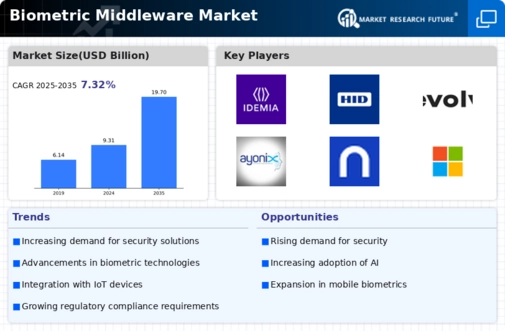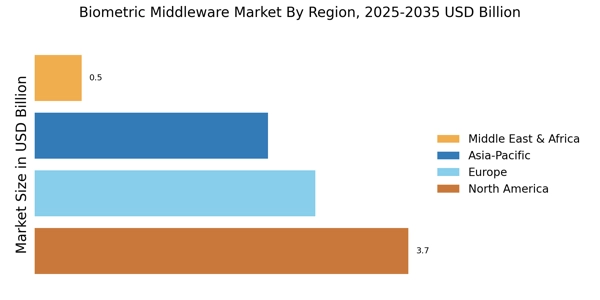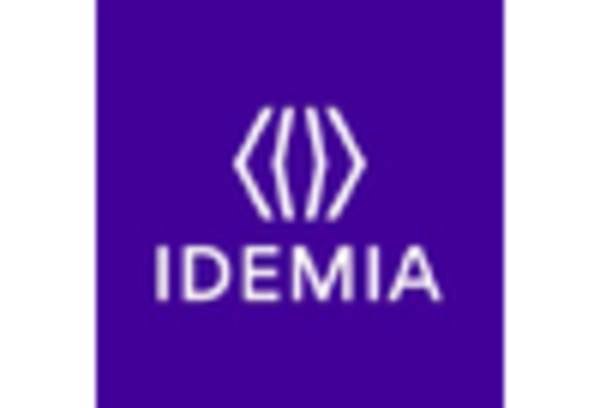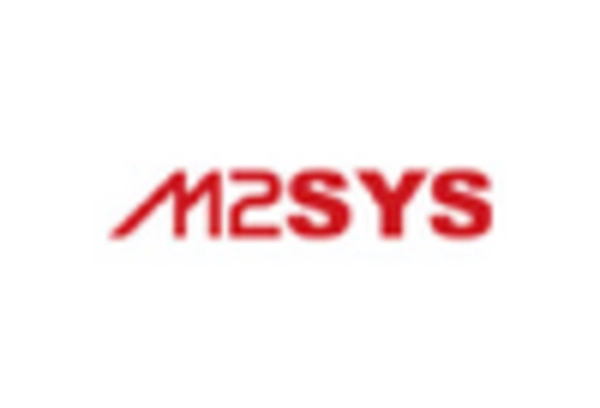Rising Security Concerns
The increasing prevalence of cyber threats and data breaches has heightened the demand for robust security solutions, thereby driving the Biometric Middleware Market. Organizations are increasingly adopting biometric systems to enhance security measures, as traditional authentication methods are often deemed insufficient. According to recent data, the biometric authentication market is projected to reach USD 40 billion by 2025, indicating a substantial growth trajectory. This trend suggests that businesses are prioritizing the integration of biometric middleware to safeguard sensitive information and ensure secure access to systems. As security concerns continue to escalate, the Biometric Middleware Market is likely to experience significant growth, with organizations seeking advanced solutions to mitigate risks associated with unauthorized access.
Technological Advancements
Rapid advancements in biometric technologies, such as facial recognition, fingerprint scanning, and iris recognition, are propelling the Biometric Middleware Market forward. Innovations in artificial intelligence and machine learning are enhancing the accuracy and efficiency of biometric systems, making them more appealing to organizations. The market for biometric middleware is expected to witness a compound annual growth rate of approximately 20% over the next few years, driven by these technological improvements. As organizations seek to leverage cutting-edge solutions, the demand for sophisticated biometric middleware that can seamlessly integrate with existing systems is likely to rise. This trend indicates a shift towards more intelligent and adaptive security solutions within the Biometric Middleware Market.
Regulatory Mandates and Compliance
The emergence of stringent regulatory mandates regarding data protection and privacy is compelling organizations to adopt biometric solutions, thus impacting the Biometric Middleware Market. Regulations such as the General Data Protection Regulation (GDPR) and various national data protection laws necessitate enhanced security measures for personal data. As organizations strive to comply with these regulations, the integration of biometric middleware becomes a viable solution to ensure secure data handling and access control. This compliance-driven demand is expected to contribute to the growth of the biometric middleware market, as organizations seek to avoid penalties and enhance their security posture in light of regulatory scrutiny.
Increased Adoption in Various Sectors
The adoption of biometric middleware is expanding across various sectors, including healthcare, finance, and government, which is significantly influencing the Biometric Middleware Market. In healthcare, for instance, biometric systems are being utilized to secure patient records and streamline access to medical facilities. The financial sector is also increasingly implementing biometric authentication to prevent fraud and enhance customer trust. Recent statistics suggest that the healthcare biometrics market alone is expected to reach USD 5 billion by 2025. This widespread adoption across diverse industries indicates a growing recognition of the benefits offered by biometric middleware, thereby driving the overall market growth.
Growing Demand for Seamless User Experience
The increasing emphasis on user experience is driving the demand for biometric solutions, which are perceived as more convenient and efficient compared to traditional authentication methods. The Biometric Middleware Market is witnessing a shift towards solutions that offer seamless integration and user-friendly interfaces. Organizations are recognizing that biometric authentication not only enhances security but also improves customer satisfaction by reducing friction during the login process. As a result, the market for biometric middleware is likely to expand, with a projected growth rate of around 15% annually. This trend underscores the importance of balancing security with user experience in the evolving landscape of the Biometric Middleware Market.


















Leave a Comment